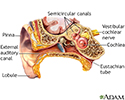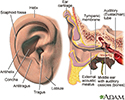Ear - blocked at high altitudes
High altitudes and blocked ears; Flying and blocked ears; Eustachian tube dysfunction - high altitude
The air pressure outside of your body changes as altitude changes. This creates a difference in pressure on the two sides of the eardrum. You may feel pressure and blockage in the ears as a result.
Pressure and blockage in the ears
Ear barotrauma is discomfort in the ear due to pressure differences between the inside and outside of the eardrum. It may include damage to the ear....

Information
The eustachian tube is a connection between the middle ear (the space deep to the eardrum) and the back of the nose and upper throat.
Swallowing or yawning opens the eustachian tube and allows air to flow into or out of the middle ear. This helps equalize pressure on either side of the eardrum.
Doing these things can unclog blocked ears when you are going up or coming down from high altitudes. Chewing gum the entire time you are changing altitudes helps by causing you to swallow often. This may prevent your ears from getting blocked.
People who always have blocked ears when flying may want to take a decongestant about an hour before the flight leaves.
If your ears are blocked, you can try breathing in, then gently breathing out while holding your nostrils and mouth closed. Use care when doing this. If you breathe out too forcefully, you can cause ear infections by forcing bacteria into your ear canals. You can also create a hole (perforation) in your eardrum if you blow too hard.
Ear infections
Otitis is a term for infection or inflammation of the ear.

References
Byyny RL, Shockley LW. Scuba diving and dysbarism. In: Marx JA, Hockberger RS, Walls RM, et al, eds. Rosen's Emergency Medicine: Concepts and Clinical Practice . 8th ed. Philadelphia, PA: Elsevier Saunders; 2014:chap 143.
O'Reilly RC, Levi J. Anatomy and physiology of the Eustachian tube. In: Flint PW, Haughey BH, Lund V, et al, eds. Cummings Otolaryngology: Head & Neck Surgery . 6th ed. Philadelphia, PA: Elsevier Saunders; 2015:chap 131.
-
Ear anatomy - illustration
The ear consists of external, middle, and inner structures. The eardrum and the 3 tiny bones conduct sound from the eardrum to the cochlea.
Ear anatomy
illustration
-
Medical findings based on ear anatomy - illustration
The external structures of the ear may aid in diagnosing some conditions by the presence or absence of normal landmarks and abnormal features including: earlobe creases, preauricular pits, and preauricular tags.
Medical findings based on ear anatomy
illustration
-
External and internal ear - illustration
The ear is a complicated organ controlling hearing and balance. When sounds waves reach the ear, they are translated into nerve impulses. These impulses then travel to the brain where they are interpreted by the brain as sound.
External and internal ear
illustration
-
Ear anatomy - illustration
The ear consists of external, middle, and inner structures. The eardrum and the 3 tiny bones conduct sound from the eardrum to the cochlea.
Ear anatomy
illustration
-
Medical findings based on ear anatomy - illustration
The external structures of the ear may aid in diagnosing some conditions by the presence or absence of normal landmarks and abnormal features including: earlobe creases, preauricular pits, and preauricular tags.
Medical findings based on ear anatomy
illustration
-
External and internal ear - illustration
The ear is a complicated organ controlling hearing and balance. When sounds waves reach the ear, they are translated into nerve impulses. These impulses then travel to the brain where they are interpreted by the brain as sound.
External and internal ear
illustration
Review Date: 5/25/2016
Reviewed By: Sumana Jothi, MD, specialist in laryngology, Assistant Clinical Professor, UCSF Otolaryngology, NCHCS VA, SFVA, San Francisco, CA. Review provided by VeriMed Healthcare Network. Also reviewed by David Zieve, MD, MHA, Isla Ogilvie, PhD, and the A.D.A.M. Editorial team.



